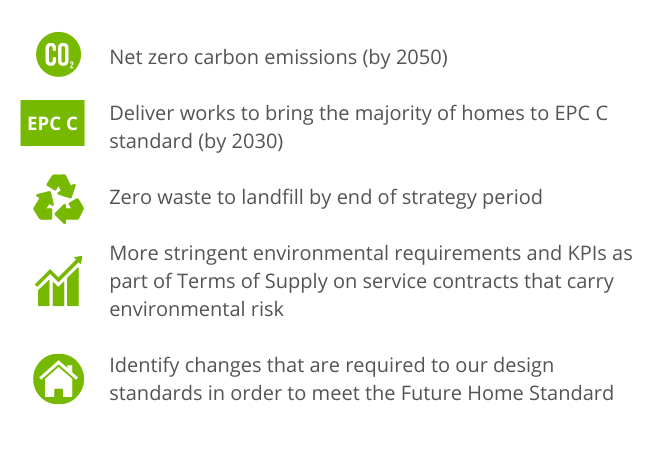Environmental sustainability
We are committed to reducing the environmental impact of our business and the way we deliver new homes and services.
Our customers and the communities where we work expect that organisations will actively seek to reduce environmental harms and promote positive ways to improve environmental sustainability.
Our strategy sets out how we will do this in a purposeful way, using the resources we have available to meet our goals, including to become a net zero carbon business.
The three core objectives of our environmental sustainability strategy are to:
Reduce our contribution to and prepare for climate change
Emissions from homes make up one of the largest contributions to climate change, mainly from gas boilers used for heating and hot water. Over the strategy period, we will need to upgrade our existing homes to meet developing government standards. We will monitor our progress each year towards our target of improving rented properties to an average of EPC Band C or above.
As well as managing carbon emissions, we need to acknowledge and prepare for climate change. To do so, we need to ensure our existing homes and new homes we develop are more resilient to extreme weather, such as flooding and overheating.
Promote biodiversity and limit pollution from our activities
Biodiversity matters because it supports the vital benefits of the natural environment, for the health and wellbeing of our customers and for the wider environment through the removal of greenhouse gases. Our contribution will include plans to enhance biodiversity throughout our green spaces, including the use of tree management strategies.
We will support local authorities in the areas where we work to implement proposals aimed at reducing air congestion and improving air quality. We will also continue to consider and mitigate risks from the use of pollutants or materials containing pollutants within our supply chain.
Throw away less and use resources responsibly
There is an increasing focus on the detrimental environmental impact of waste from single use plastics and other non-biodegradable materials. We will work with our supply chain to continually improve the sustainability of the materials, goods and services we use. This includes amending our procurement processes to include questions related to environmental performance.
Assessing our current waste management and disposal arrangements for both corporate and operation waste will help us to develop a plan to reduce and eventually send zero waste to landfill.
We will also look at ways we can help residents to reduce their water consumption.
Our targets include:

How we're doing so far
Our progress against this strategy
At March 2023:
Greenhouse gas reporting: We’ve improved our approach to reporting Greenhouse Gas, focusing on the accuracy and completeness of our data. Our total reported emissions (mt CO2 e) decreased compared to the previous year largely driven by better data on the energy efficiency of our homes, but our combined Scope 1 and 2 emissions (from our vehicle fleet and utilities costs for offices) also went down.
Waste management: We’ve improved waste management by implementing a waste action plan. This plan is to reduce landfill waste from our operations to zero, eliminating landfill tax expenses by 2026 and decreasing reported greenhouse gas emissions.
Biodiversity commitment: We’ve adopted a Biodiversity Policy and plan to secure and monitor Biodiversity Net Gain for new developments and our existing estate. Policies and action plans are in place to enhance biodiversity across our existing estate and effectively manage Biodiversity Net Gain schemes for future developments.
Project support for sustainability: We provided coordination and support for a project at Oak Farm. The project identified customer experience and operational issues related to Air Source Heat Pump installations. It also developed approaches to support customers, meeting their needs and reducing energy demand.
